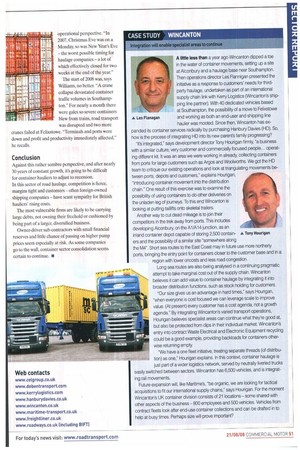WINCANTON
Page 51

If you've noticed an error in this article please click here to report it so we can fix it.
A little less than a year ago Wincanton dipped a toe in the water of container movements, setting up a site at Alconbury and a haulage base near Southampton. Then operations director Les Flannigan presented the initiative as a response to customers' needs for thirdparty haulage, undertaken as part of an international supply chain link with Kerry Logistics (Wincanton's shipping line partner). With 40 dedicated vehicles based at Southampton, the possibility of a move to Felixstowe and working as both an end-user and shipping line haulier was mooted. Since then, Wincanton has expanded its container services radically by purchasing Hanbury Davies (HD). So, how is the process of integrating HD into its new parents family progressing?
"It's integrated," says development director Tony Hourigan firmly, 'a business with a similar culture, very customer and commercially focused people... operating different kit. It was an area we were working in already, collecting containers from ports for large customers such as Argos and Woolworths. We got the HD team to critique our existing operations and look at triangulating movements between ports, depots and customers," explains Hourigan, "introducing container movement into the distribution chain." One result of this exercise was to examine the possibility of using containers to do other deliveries on the unladen leg of journeys. To this end Wincanton is looking at putting taillifts onto skeletal trailers.
Another way to cut dead mileage is to join their competitors in the trek away from ports. This includes developing Alconbury, on the A1/A14 junction, as an inland container depot capable of storing 2,500 containers and the possibility of a similar site "somewhere along the M4". Short sea routes to the East Coast may in future use more northerly ports, bringing the entry point for containers closer to the customer base and in a region with lower oncosts and less road congestion. A Les Flanagan A Tony Hourigan
Long sea routes are also being analysed in a continuing pragmatic attempt to take marginal cost out of the supply chain. Wincanton believes it can add value to container haulage by integrating it into broader distribution functions, such as stock holding for customers.
"Our size gives us an advantage in hard times," says Hourigan, "when everyone is cost focused we can leverage scale to improve value. (At present) every customer has a cost agenda, not a growth agenda." By integrating Wincanton's varied transport operations, Hourigan believes specialist areas can continue what they're good at, but also be protected from dips in their individual market. Wincanton's entry into contract Waste Electrical and Electronic Equipment recycling could be a good example, providing backloads for containers otherwise returning empty.
"We have a one fleet initiative, treating separate threads (of distribution) as one," Hourigan explains. In this context, container haulage is just part of a wider logistics network, served by neutrally livened trucks easily switched between sectors. Wincanton has 6,500 vehicles, and is integrating rail movements.
Future expansion will, like Maritime's, "be organic, we are looking for tactical acquisitions to fit our international supply chains," says Hourigan. For the moment Wincanton's UK container division consists of 21 locations some shared with other aspects of the business -800 employees and 500 vehicles. Vehicles from contract fleets look after end-use container collections and can be drafted in to help at busy times. Perhaps size will prove important?












































































































































































